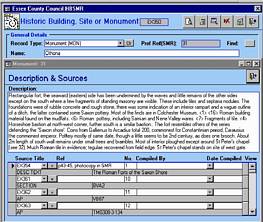The most recent survey of computer usage in SMRs (Baker 1999) found that the most common database management system in use was the Microsoft Access-based application developed by the Exegesis company (Fig. 2). Since Baker's survey, the number of SMRs using this system (in the absence of a name, normally known as 'Exegesis') has continued to rise.

Figure 2: Sample screen from the Exegesis
system
Exegesis has been built on national standards of data structure and terminology, the latter including English Heritage's Thesaurus of Monument Types. The structure of the database is driven by the so-called 'Event — Source — Monument' model (Bourn 1999). This was propounded several years ago by Glen Foard and Steve Catney. Put most simply, this involves the separation of information into facts, as represented by the data generated by fieldwork, the publication of these facts in 'sources', and their interpretation as 'monuments'. This ought to allow researchers to use the core data in SMRs in a more flexible and creative way than earlier monument-based systems, especially those limited to 'flat-file' databases. At the least, implementation of this model should bring greater clarity of structure to SMR collections, made up as they are of data collected from a wide variety of sources. The application of the model has resulted in continued discussion and debate. One example concerns the place and recording of finds in this structure — are they related to monuments, or events, or both? There is also the issue of recording monuments themselves and the possible advantages of a structured, hierarchical approach. For example, a monastic complex could be recorded using one record for the complex as a whole and related records for the constituent parts such as the church, cloisters and so on.
Unfortunately, most, if not all, of the argument about SMR structures
has been amongst SMR practitioners. Indeed, at the Archaeology
Informatics seminar in Glasgow, some attendees seemed uncertain of the
benefits the new model might bring for academic users. On the other
hand, when questioned, they were unable to suggest alternatives and
the debate points to the lack of academic engagement in SMR
development, and the need to ensure increased involvement in the
future to try and ensure SMRs meet their needs.
© Internet Archaeology
URL: http://intarch.ac.uk/journal/issue15/3/pg10.html
Last updated: Wed Jan 28 2004